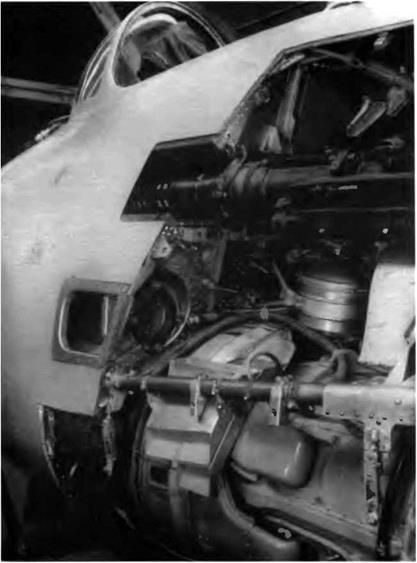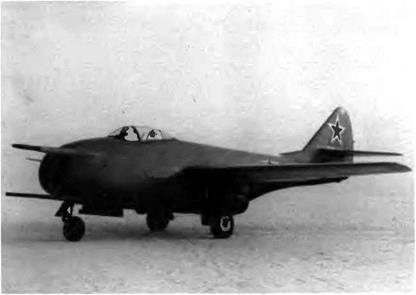MiG 9M /1308 / FR
The engine flameout that occurred when all three cannons were fired at once puzzled OKB engineers and led them to examine the stability of the combustion process at that moment. This mystery was solved by degrees. It was thought that the solution lay in shifting the cannon
|
The MiG-9M’s left armament bay. The lower NS-23 has been removed. The N-37 cannon was on the right side of the aircraft’s nose. |
muzzles behind the engine air intake plane On the FR, all three cannons were moved aft: the N-37 was relocated to the right side of the fuselage, and both of the NS-23s were placed on the left side. This new arrangement entailed a few structural modifications of the nose section. The two RD-20s were replaced by RD-21s built at an OKB man-
|
The MiG-9M and the first production MiG-9s were fitted with the airbrakes tested on the UTI MiG-9. |
aged by D. V. Kolosov. This was basically a "hotted-up" RD-20 rated at 980 daN (1,000 kg st).
The FR was also equipped with airbrakes first tested on a UTI MiG – 9 as well as a pressurized cockpit. Five of the six original fuel tanks were retained—including a 100-1 (26-US gallon) trim tank—but the total capacity remained unchanged at 1,300 kg (2,865 pounds).
The first FR was rolled out in June 1947 and flown in July by V N. Yuganov. The data recorded during the flight tests showed that it was the first MiG to exceed M 0 8. Thanks to the greater thrust of the RD – 21, the level-speed increase reached 55 km/h (30 kt). The rate of climb also improved: the MiG-9M climbed to 5,000 m (16,400 feet) in 2 minutes 42 seconds, 1 minute 36 seconds faster than any other aircraft in the same category.
The MiG-9M served as a basic model for the design of both the FL and the FN, two more powerful and sturdier versions that were built but never flown.
Specifications
Span, 10 m (32 ft 9.7 in); length, 9.83 m (32 ft 3 in); height, 3.225 m (10 ft 6.7 in); wheel track, 1 95 m (6 ft 4 8 in); wheel base, 3.072 m (10 ft 0.9 in); wing area, 18.2 m2 (195.9 sq ft); empty weight, 3,356 kg
|
The FP marked another attempt to end the engine flameout problems that occurred when the cannons were fired simultaneously. The N-37 cannon was moved from the air intake partition wall to the left upper part of the nose. |
(7,397 lb); takeoff weight, 5,069 kg (11,172 lb); fuel, 1,300 kg (2,865 lb); wing loading, 278.5 kg/m2 (57.1 lb/sq ft); max operating limit load factor, 5.5.
Performance
Max speed, 965 km/h at 5,000 m (521 kt at 16,400 ft); max speed at sea level, 850 km/h (459 kt); climb to 5,000 m (16,400 ft) in 2.7 min; service ceiling, 13,000 m (42,640 ft); landing speed, 166 km/h (90 kt); range, 830 km (515 mi); takeoff roll, 830 m (2,720 ft); landing roll, 700 m (2,295 ft).













